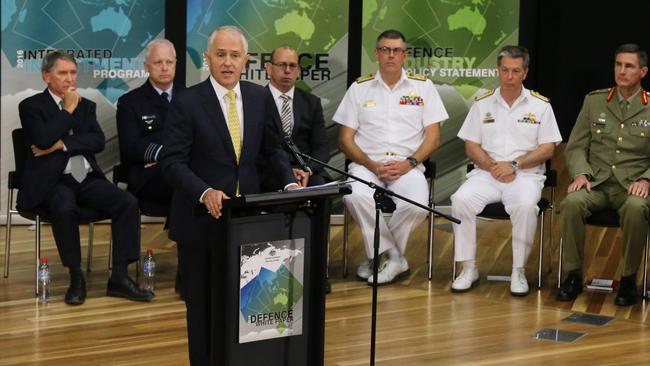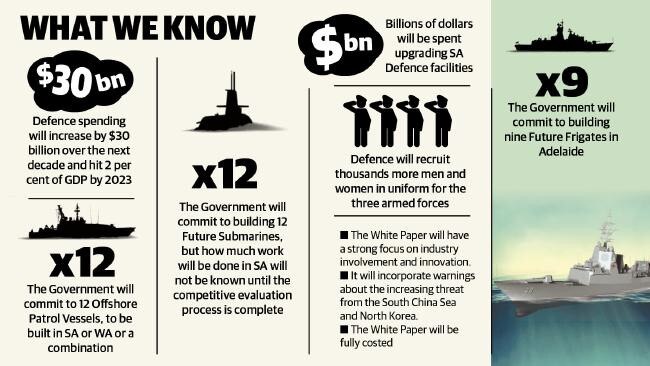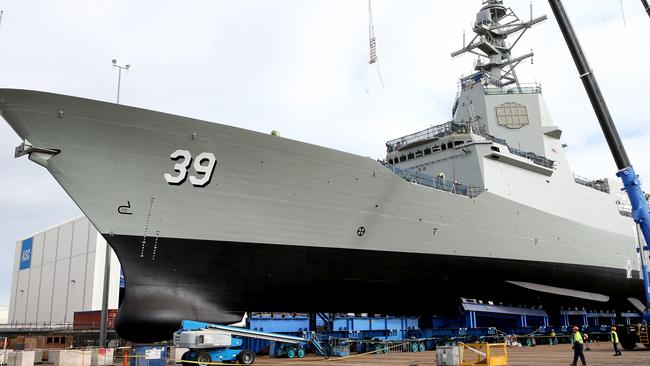Defence White Paper: Future submarines could cost up to $150 billion
THE Federal Government will spend $195 billion over the next decade beefing up the capability of Australia’s armed forces — and SA stands to benefit from a focus on maritime projects. | What Defence paper means for SA

SA News
Don't miss out on the headlines from SA News. Followed categories will be added to My News.
- REACTION: Defence paper ‘unambiguous win for SA’
- Tory Shepherd: Shift in focus a boon for SA
- Fears WA will win offshore patrol vessel contract
- Defence White Paper calls for 5000 more troops
- Submarine Dossier: Blueprint for our Future
THE Federal Government will spend $195 billion over the next decade beefing up the capability of Australia’s armed forces — and SA stands to benefit from a focus on maritime projects.
The long-awaited Defence White Paper, released today, reveals that the future submarines project could cost up to $150 billion — three times the original estimate.
It will cost more than $50 billion just to buy them.
But Defence officials and industry experts consistently say acquisition is only one third of the cost, which theoretically puts the whole cost at $150 billion.
Since former prime minister Tony Abbott announced that $89 billion would be spent on submarines and surface ships last year, the Government had maintained that the $50 billion figure included their lifetime sustainment.
South Australia is well placed to gain a substantial share of the submarine project, while the Government has already vowed that shipbuilding will be centred in this state.
Woomera training and testing range has also been listed as one of several bases to be expanded across the country.

As revealed by The Advertiser this morning, the White Paper promises 12 new submarines, nine new frigates, 12 new offshore patrol vessels and 15 aircraft in a $195 billion spend.
The fleet of six Collins Class submarines will be replaced with 12 new “regionally superior” ones — the highest defence procurement in Australian history.
They will begin to enter service from the early 2030s to about 2050.
The 12 new offshore patrol vessels will enter service early next decade, around the same time as the three new Hobart Class Air Warfare Destroyers, while the nine new frigates will be introduced into service from the late 2020s.
Australia will also get a land-based missile launcher able to target ships and long-range rocket launchers.

The Turnbull Government vowed to increase defence spending to two per cent of GDP by 2020-21, years sooner than the Coalition’s 2013 election promise.
This includes an extra $29.9 billion in spending over the next decade.
Strike and air combat abilities will be enhanced to deliver “more potent” air strikes.
And cyber capabilities including electronic warfare and surveillance will be boosted in the face of “growing” cyber security threats, which the document said poses “a real and present risk to the Australian Defence Force’s warfighting capability, and our national security and economic prosperity”.
Defence information and communications technology infrastructure will be improved, through $5 billion of additional funding.
The ADF’s permanent workforce will also be increased to about 62,400 by 2025-26 in what is described as the “largest single rebalance of the defence workforce in a generation”.
As well as cyber security, the white paper outlines five other “drivers” behind the spending boost — which will see the defence budget grown from $32.4 billion in 2016-17 to $58.7 billion in 2025-26, including:
AUSTRALIA’S relationship with China and the US;
THREATS posed by Islamic State and other terrorist groups; and
INCREASING military modernisation in Asia

The report said the Indo-Pacific region was experiencing “unprecedented transformation”.
“In the next 20 years, half of the world’s submarines and at least half of the world’s advanced combat aircraft will be operating in our region,” it said.
The report said Australia would “continue to be threatened by terrorism at home and abroad”.
“The spread of extremism and violence will be worsened by foreign terrorist fighters returning from conflicts to their countries of origin, including Australia and other countries in our region, and terrorist attacks by individuals inspired and radicalised by extremist messages,” it said.
“Over the next 20 years, it can be expected that terrorism will continue to evolve in ways that threaten Australia’s interests.”
Prime Minister Malcolm Turnbull said the White Paper would help Australia “achieve a strong and sustainable defence capability.”
“It is a program that ensures that much more of the development of our defence technologies is done here in Australia,” he said.
“Our defence industry already leads in innovation, with strong, spill over benefits into the wider economy.
“We want to and we will see more of this.”
He said ongoing turbulence in the Middle East and Asia was a continued threat.
“The proliferation of terrorist threat sources, some of them home grown, many of them enlisted via the internet, will require sustained effort both within Australia and elsewhere to limit the freedom of terrorist groups to operate and as we seek to undermine their narrative of hate,” he said.
“We will continue to be a constructive and influential player in the regional strategic environment and beyond.
“We need to have the capacity to deter and defeat threats to Australia.”

Defence Minister Marise Payne said in future defence would play a more central role in “shaping regional affairs”.
“As an open trade-based economy, Australia relies on a stable and secure region,” she said.
“Our security and prosperity depends on a stable Indo-Pacific region and a rules-based global order in which power is not misused and tensions can be managed through negotiations based on international law.
“To achieve this, our Defence Force must continue to have a leadership role in our immediate region, comprising Papua New Guinea, Timor Leste and Pacific Island countries.
“We must strengthen our defence engagement with regional countries to deal with the threat of terrorism and address shared security concerns.
“And we must continue to work with the United States and international and regional partners to make that positive contribution beyond the Indo-Pacific as Australia is currently doing in Iraq and Syria and Afghanistan.”
Earlier today, Senator Payne described the situation in the South China Sea as a “very complex environment”.
She said Australia faced “some very significant and constantly changing threats.”
“The threat that Daesh poses to us on our own shores, in our region, and then further afield, where the men and women of the ADF are participating in the task against Daesh in Syria and Iraq, is one that changes every day,” she told the ABC.
The defence blueprint had been delayed by the Liberal leadership spill in September.


